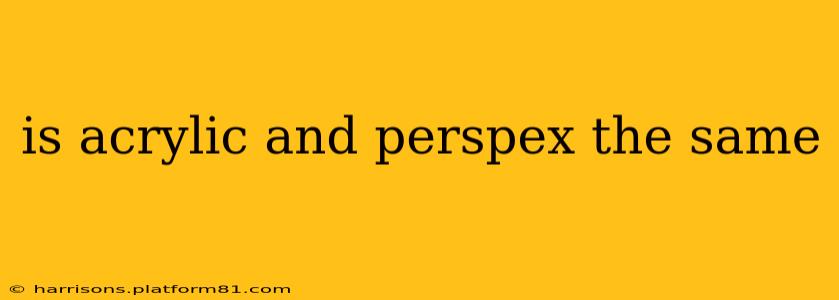Is Acrylic and Perspex the Same? Understanding the Differences
The terms "acrylic" and "Perspex" are often used interchangeably, leading to confusion. While closely related, they aren't exactly the same. This article clarifies the distinction between these two materials, addressing common questions and misconceptions.
What is Acrylic?
Acrylic is a generic term referring to a family of thermoplastic polymers. These polymers are known for their transparency, durability, and versatility. They are created through a polymerization process involving acrylic monomers. Many different types of acrylic exist, each with varying properties depending on the specific monomers used and the manufacturing process. This means you can have acrylic sheets that are flexible or rigid, shatter-resistant or brittle, and so on.
What is Perspex?
Perspex is a brand name, specifically a trademark of Lucite International, for a type of cast acrylic sheet. It's not a material in itself, but rather a specific high-quality brand of acrylic plastic with excellent optical clarity and impact resistance. Think of it like Kleenex versus facial tissue – Kleenex is a brand, and facial tissue is the generic product category.
So, are they the same?
No, they aren't precisely the same. All Perspex is acrylic, but not all acrylic is Perspex. Perspex represents a high-quality, branded version of cast acrylic, known for its superior clarity and performance characteristics. Other manufacturers produce acrylic sheets, some meeting similar standards to Perspex, while others may have different properties.
What are the key differences between acrylic and Perspex?
While the chemical composition may be similar, the differences primarily lie in quality control, manufacturing processes, and branding:
- Quality Control: Perspex undergoes rigorous quality control measures during its manufacturing process, ensuring consistent quality and performance. Other acrylic sheet manufacturers may have varying levels of quality control.
- Manufacturing Process: The specific manufacturing processes used to create Perspex contribute to its superior clarity and other properties. These processes may differ from those used by other acrylic producers.
- Branding and Reputation: Perspex benefits from extensive brand recognition and a strong reputation for quality, influencing its perceived value.
Which is better: Acrylic or Perspex?
The "better" choice depends entirely on your needs and budget. If high optical clarity, exceptional impact resistance, and consistent quality are paramount, Perspex might be the preferred choice, although it typically comes at a higher cost. However, for many applications, a standard acrylic sheet from another reputable manufacturer will suffice and offer a more budget-friendly option.
What are some common uses for acrylic and Perspex?
Both acrylic and Perspex are used in a wide range of applications, including:
- Signage: Their clarity and durability make them ideal for indoor and outdoor signs.
- Displays: They are often used to create clear, protective displays for products or exhibits.
- Protective shields: Their impact resistance makes them suitable for applications requiring protection, such as safety screens.
- Lighting: They are used in lighting fixtures due to their ability to transmit light efficiently.
- Furniture: Acrylic and Perspex are used to create stylish and modern furniture elements.
Is Perspex more expensive than standard acrylic?
Generally, yes. Due to its higher quality, rigorous manufacturing process, and strong brand recognition, Perspex typically commands a higher price than generic acrylic sheets.
In conclusion, while the terms are often used interchangeably, it's important to understand that Perspex is a specific brand of high-quality cast acrylic, while acrylic is a broader category of thermoplastic polymers. The best choice depends on your specific requirements and budget.
